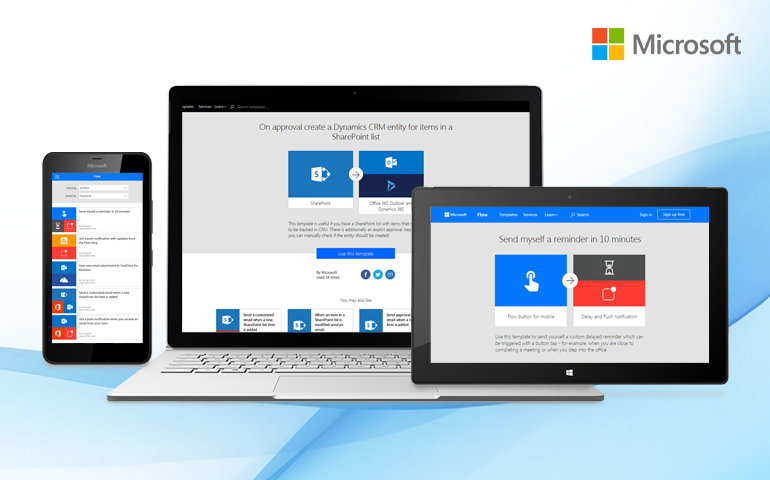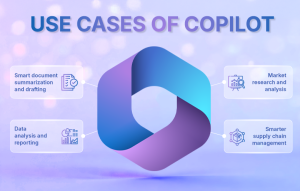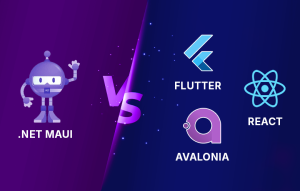Microsoft has announced the launch of its Microsoft Flow – a cloud-based service on Monday, October 31, 2016, to elevate business automation for enterprises worldwide. Let’s go through to know how it can help organizations across the world leverage its potential benefits.
We all are aware of the fact that each and every organization has a common objective of giving more output with the least amount of resources. Besides, people in every department – whether it’s sales and marketing, operations, finance, customer service, accounts or HR, need a powerful workflow to improve their own processes. While technology is often crucial for operating more effectively and efficiently, the costs and complexities have often obstructed organizations from making the most out of the potential benefits. The growth of SaaS (software as a service) has pulled down the barriers by eliminating the need to deploy servers or to install and configure complex software systems. So, all you need to do is just sign up and go.
It’s absolutely true that not every business problem can be fixed with off-the-shelf solutions. However, you can always develop custom solutions these days, which traditionally used to be expensive and time consuming for a lot of business needs – especially those projects that are integrated across multiple data sources or require delivery on multiple devices from desktop to mobile. Consequently, too many technology requirements end up unresolved or under-optimized.
Thus, to fill in this gap Microsoft has launched “Microsoft Flow”.
What is Microsoft Flow
Microsoft Flow is a comprehensive workflow management platform for systematizing workflows for various applications and services by connecting web services, cloud-based data, and files. It facilitates users in creating workflows to reduce time-consuming tasks or processes, send/receive notifications, collect/organize and update data and synchronize files. Enterprises no longer create personalized workflows every time, instead, they are shifting towards Microsoft Flow as it provides support for several scenarios by bringing together two or more cloud services with the creation of workflows.
There are many pre-built templates you can use if they satisfy current business needs. All you need is to sign-in for the pre-built templates to connect to the services you are trying to access. Once the access is granted, you can view all of the triggers, actions, and settings that help in making the flow function. You can also create your own flows depending on your need to connect with Microsoft services or non-Microsoft services, or vice-versa. Also, you can add, change, or delete actions for creating your own flow. You can also create flows from scratch by making use of various data sources such as SharePoint lists, Excel files, Azure SQL tables, and more.
Some features of Microsoft Flow
- Get notifications, manage your flows, and trigger manual flows with just a tap of a button with the Microsoft
- Flow mobile app for iOS or Android.
- Provide support for text messages via Twilio.
- Provide different types of connectors that enable you to exchange data between SharePoint Online (On-Premises also) and a variety of Microsoft as well as third-party services.
- Enables you to create, update, new items and documents in SharePoint Online and also send notifications.
- Enables creating custom APIs in Microsoft Flow.
- Helps to connect with Power BI and enables the use of Azure services such as blob storage, resource manager and DocumentDB.
- The Microsoft Flow’s Admin Center allows you to create environments, manage permission and set up Data Loss Prevention (DLP) policies.
- Create and customize Microsoft Flow instead of SharePoint custom Workflow easily.
- Supports business automation in 42 languages and 6 regions.
- Microsoft Flow enriches both Office 365 and Dynamics 365 with new workflow capabilities.
- Save hashtag tweets on a SharePoint list.
- Creation of CRM entities based on the SharePoint list.
- Copy file between SharePoint and OneDrive, Dropbox and SharePoint
- Microsoft Flow offers more connectivity to Microsoft and third-party services;
– Business services such as OneDrive for Business, SalesForce.com, Dynamics 365, Google Drive, Azure, Power BI, SQL Server, Cognitive Services Text Analytics etc.
– Social services such as Facebook, Twitter, Yammer, YouTube, Slack, Pinterest, Basecamp 3, etc.
Why choose Microsoft Flow for your business
As you would have known by now that Microsoft Flow offers multiple approaches and functionalities to ease your business operations. Besides, you also have an option of using the mobile apps for iPhone and Android to monitor as well as manage your flows. Office 365 is not a requisite and you can have up to 25 flows in your account. Now handle your organization’s flow with enterprise-grade control, take actions rapidly and get notifications on the move. Also, it helps in reducing implementation timelines, since it eliminates the need for coding. Moreover, it increases 3rd party integration capabilities of SharePoint.
However, if you are not skilled at creating flows for your business needs on your own, hire our experts who are proficient in creating flows to perform various steps/actions to diverse services, request for an approval, run on a schedule, or to add a flow to an app.









